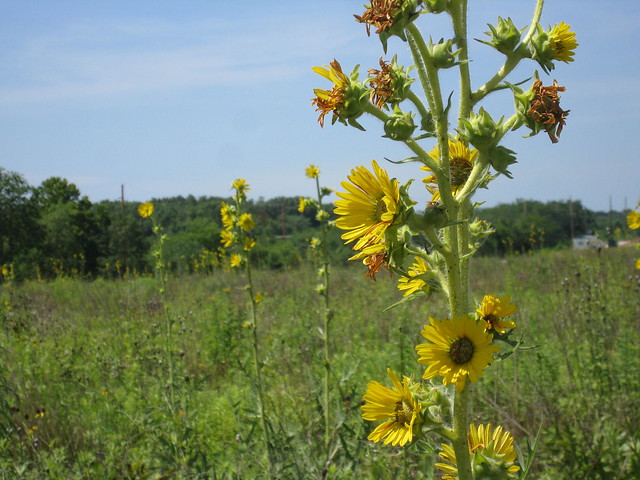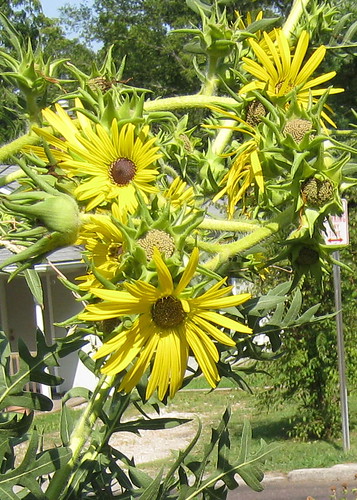 |
| Compass Plant blooms at Howell Prairie, St. Charles Co., MO AMcC |
My first reason for wanting to find Compass plant for my yard is the tale that it can be used as a compass. Now that my plants are large, I can say that the tale is true—mostly. Compass plant (Silphium laciniatum) is a plant of tall grass prairies and glades and everything about it shows is adaptated to dry conditions with blazing sun. Leaves and stem are hispid, as the botanists say; or covered with “little tiny hairs,” as Jonathan Winters would say. The stiff white hairs reflect light, effectively protecting the plant’s tissues against the sun.
Presumably, they also discourage deer and antelope from snacking on it as they play on the range. Instead of large, light-gathering leaves on a tropical philodendron, Compass plant’s leaves are large but deeply cut, reducing the surface area. Merv Wallace at Missouri Wildflowers Nursery says they look like “green flames.” The plant’s best trick is to move those leaves around during the day so that they face east and west, presenting only a narrow edge to the scorching south. Now the leaf points north, hence, the name. Of course, if the plant is shaded by something, the leaves may face any direction, so navigators beware!
 |
| Leaves point north AMcC |
I wonder what the first Europeans thought of Compass plant when they first explored the tall grass prairies of the Midwest. It towers up to 8 feet, with a tough, thick stem, topped with 2 to 3 inch sunny flowers. Many sources mention that the Indians used the resin in the top part of the stem for chewing gum. The Pawnee used the dried root as a medicine, given in tea. I don’t envy the job the Pawnee women had, trying to dig the huge taproot in dry soil, using only a sharpened stick.
In Ozark Wildflowers, Kurz tells us that the Omaha and Ponca believed the plant attracted lightning and would not camp near it. It makes sense if you image mile after mile of treeless, tall grass prairie. Compass plant could very well be the tallest structure out there. Tall things can be at a premium for birds on the prairie. Meadowlarks and sparrows need to make their presence known so they can defend territory and find a mate, and Compass plant stalks are just the ticket. On a birding trip to southeast Arizona, I noticed that some of the Arizona birders tied Agave stalks to their fences, providing an attractive perch for hummers. I couldn’t get an Agave stalk into my carry-on, so I use last season’s Compass plant stalk for my hummers.
If you grow Compass plant, remember that it takes a few years for it to bloom, growing from seed. Once your plant sends up its tall stalk from the leaves at the base, stake it at least by June, with a heavy stake, driven in deeply. Out on the prairie it wouldn’t matter if a few stalks fell over in a storm, there would still be many of them blooming. But we gardeners don’t have that kind of space. Horizontal blooms don’t really impress in the garden.
 |
| Compass Plant blooming in August AMcC |
Several insects depend soley or partly on Compass plant: the Silphium beetle, Rynchites sp. and the prairie cicada, Okanagana balli, which the Illinois Dept of Natural Resources calls, “the rarest large insect in Illinois.” Studies on this insect in Kansas found that although it occurs on remnant native prairies, it has never been found on a restored prairie. I was unable to find out if the prairie cicada occurs in my home state, Missouri.
Cattle and horses do eat Compass plant, according to the USDA Natural Resources Conservation Service. I like to look out at my plants and imagine buffalo grazing on Compass plant. The buffalo wouldn’t stay long in my yard—I only have two plants. I bet the plants would grow back though. Dr. John Hilty’s website says that Compass plant can live for 100 years!
Presumably the 8' tall big bluestems also help hold up these plants.
ReplyDeleteInteresting about Okanagana balli occurring only on remnant native prairies and not restored parcels. I've noted the same thing for the swift tiger beetle, Cylindera celeripes in Missouri's loess hilltop prairies on restored prairies that look like they should be perfect for the beetle.
To my knowledge, Okanagana balli has not been recorded in Missouri - its occurrence in Iowa, Kansas, and now Illinois suggests it should be. Might be a good target to add to the list.
You bring up a great idea for an experiment. Next year I might try to get some big bluestem started next to the compass plant.
ReplyDeleteAnd your comments about swift tiger beetle shows that although we can't recognize a fully functioning prairie, insects can. Thanks for the information about prairie cicada! It would be so cool to discover one!
Anne,
ReplyDeleteI would gladly send you a hundred of the Okanagana Ballis. I live in South West Wyoming and just this week these large insects have emerged from beneath my trees and they are driving me nuts. They make a deafening rattle like sound. I do think listening to a few of them might be ok but hundreds or thousands is a bit much.
Heather
You have my sympathy Heather--we had the "Great Southern Brood 2 years ago at this time. Some people were driven nuts and made them into ice cream! Thanks for your visit & comment!
ReplyDelete